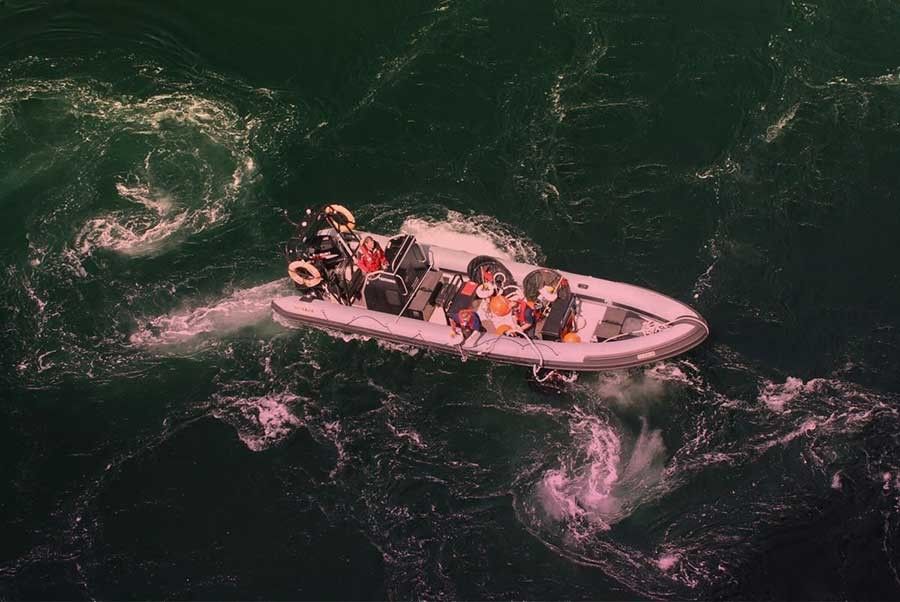Scottish Association for Marine Science (SAMS)
Roaming in the Deep

By Euan Paterson, Scottish Association for Marine Science (SAMS).
It’s 2am on a Sunday morning and a marine robotics technician from the Oban based Scottish Association for Marine Science (SAMS) is rudely awakened by the ping of an incoming text message.
For most of us, this would prompt a momentary mid-night panic over which relative or friend needed help so urgently. For the marine scientist or technician, this is simply a ‘job done’ message from one of their robotic systems, floating somewhere in the north east Atlantic and ready for its next mission.
SAMS operates a fleet of autonomous underwater vehicles (AUVs) charged with exploring hard-to-reach areas of the ocean, particularly in winter months when a trip on a research vessel would test the constitution of even the most experienced seafarers.
These autonomous oceanographers can work in the harshest of conditions for months at a time, collecting huge amounts of data – and they don’t have any dietary requirements.
One such AUV is known as a Glider. Built for endurance missions, these three-metre, torpedo-shaped submarines can last for several months at sea. Contending with swelling seas and force 10 gales, they collect crucial oceanographic data such as temperature and oxygen levels and help scientists to determine movements in the ocean.
Diving to depths of 1,000 metres and travelling at a snail’s pace of 25 centimetres per second, autonomous Gliders can be ‘piloted’ from anywhere with an internet connection, including a smart phone. They have no propulsion, instead using a combination of pressure changes within its casing to change buoyancy and a sliding battery to alter its pitch to move through the water column.

By collecting swathes of data throughout the year, including the harsh winter months, Gliders can vastly improve the resolution in which we view physical changes in the ocean and, subsequently, the global climate.
SAMS also operates two types of short-endurance AUVs and remotely piloted aircraft (RPA) from its Scottish Marine Robotics Facility, which serves as a national capability for researchers throughout the UK and is funded by the Natural Environment Research Council.
These AUVs and RPAs have not only increased the capacity of data collection but have traversed the various disciplines within marine science, complementing research on the deep sea, biogeochemistry, marine biology, microbiology and oceanography among others.
One AUV, the Teledyne Gavia, has been used to survey the face of Arctic glaciers, a task too dangerous for researchers on a vessel, and has been deployed on seabed surveys in very shallow water.
The introduction of this technology has also opened up new possibilities for novel applications to support both research and industry.
Investigations are already underway to determine how these underwater robots may help the aquaculture industry detect toxic algal blooms, map habitats that could become part of a Marine Protected Area, or help the oil industry trace leaks from underwater pipelines.
To ensure that robotics continue to support and enhance our science, SAMS has partnered with some of the UK’s top marine institutes to provide a Centre for Doctoral Training. The centre, known as NEXUSS (Next Generation Unmanned Systems Science), is jointly funded by NERC and the Engineering and Physical Sciences Research Council (EPSRC) and aims to develop a generation of future environmental science leaders.
This advance in technology has been complementary to the more traditional methods of data collection and, while researchers have access to more data than ever before, our leading marine scientists will still be required to scrutinise and translate the data collected by robotic systems.
The ocean covers 71 per cent of the earth and the vast majority of this immense ecosystem is yet to be discovered. With the potential of autonomous marine robotics yet to be realised, it may not be long before we can shine more light on one of the largely unexplored wonders of our planet.
With thanks to Euan Paterson and everyone at SAMS.
Create an event with world changing ideas: Conventionscotland.com | legends@visitscotland.com